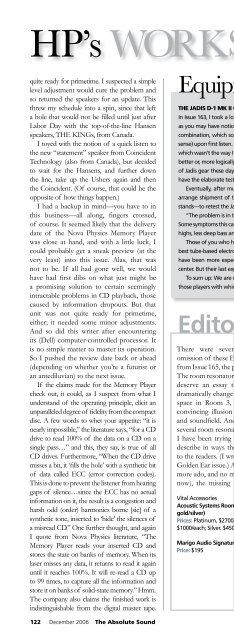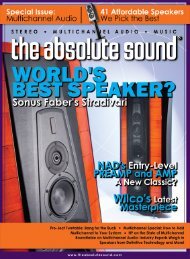Create successful ePaper yourself
Turn your PDF publications into a flip-book with our unique Google optimized e-Paper software.
HP’s Workshop<br />
quite ready for primetime. I suspected a simple<br />
level adjustment would cure the problem and<br />
so returned the speakers for an update. This<br />
threw my schedule into a spin, since that left<br />
a hole that would not be filled until just after<br />
Labor Day with the top-of-the-line Hansen<br />
speakers, THE KINGs, from Canada.<br />
I toyed with the notion of a quick listen to<br />
the new “statement” speaker from Coincident<br />
Technology (also from Canada), but decided<br />
to wait for the Hansens, and further down<br />
the line, take up the Ushers again and then<br />
the Coincident. (Of course, that could be the<br />
opposite of how things happen.)<br />
I had a backup in mind—you have to in<br />
this business—all along, fingers crossed,<br />
of course. It seemed likely that the delivery<br />
date of the Nova Physics Memory Player<br />
was close at hand, and with a little luck, I<br />
could probably get a sneak preview (at the<br />
very least) into this issue. Alas, that was<br />
not to be. If all had gone well, we would<br />
have had first dibs on what just might be<br />
a promising solution to certain seemingly<br />
intractable problems in CD playback, those<br />
caused by information dropouts. But that<br />
unit was not quite ready for primetime,<br />
either; it needed some minor adjustments.<br />
And so did this writer after encountering<br />
its (Dell) computer-controlled processor. It<br />
is no simple matter to master its operation.<br />
So I pushed the review date back or ahead<br />
(depending on whether you’re a futurist or<br />
an antediluvian) to the next issue.<br />
If the claims made for the Memory Player<br />
check out, it could, as I suspect from what I<br />
understand of the operating principle, elicit an<br />
unparalleled degree of fidelity from the compact<br />
disc. A few words to whet your appetite: “it is<br />
nearly impossible,” the literature says, “for a CD<br />
drive to read 100% of the data on a CD on a<br />
single pass…” and this, they say, is true of all<br />
CD drives. Furthermore, “When the CD drive<br />
misses a bit, it ‘fills the hole’ with a synthetic bit<br />
of data called ECC (error correction codes).<br />
This is done to prevent the listener from hearing<br />
gaps of silence…since the ECC has no actual<br />
information on it, the result is a congestion and<br />
harsh odd (order) harmonics borne [sic] of a<br />
synthetic tone, inserted to ‘hide’ the silences of<br />
a misread CD.” One further thought, and again<br />
I quote from Nova Physics literature, “The<br />
Memory Player reads your inserted CD and<br />
stores the state on banks of memory. When its<br />
laser misses any data, it returns to read it again<br />
until it reaches 100%. It will re-read a CD up<br />
to 99 times, to capture all the information and<br />
store it on banks of solid-state memory.” Hmm.<br />
The company also claims the finished work is<br />
indistinguishable from the digital master tape.<br />
Equipment Updates<br />
The Jadis D-1 Mk II CD Transport and JS-1 MkIII DAC<br />
In Issue 163, I took a long look at a handful of CD players to assess the present-day state of the art. Not,<br />
as you may have noticed, every last one on the market. The most troublesome of the lot was the Jadis<br />
combination, which sounded rather spectacular, big, bold and even a bit juicy (in the musically positive<br />
sense) upon first listen. But, some time later, in the survey, I found the unit sadly deficient in the top octave,<br />
which wasn’t the way I first heard things. I wasn’t entirely sure whether the other players were that much<br />
better or, more logically, whether something had gone awry with the Jadis. The North American importer<br />
of Jadis gear these days is Pierre Gabriel, who is based in Quebec, and whose local contact man did not<br />
have the elaborate test gear necessary to determine what, if anything, was wrong with the player.<br />
Eventually, after much ado with messages flying back and forth across the border, we managed to<br />
arrange shipment of the units (player and processor) back to Gabriel and offered—an offer that still<br />
stands—to retest the Jadis if he found problems with it. Gabriel tested the unit and sent us these notes…<br />
“The problem is in the D/A Converter’s right channel, the 5814 double-triode tube, positive phase….”<br />
Some symptoms this caused (and we heard here in Sea Cliff) were an “unnatural top end, confusion in the<br />
highs, less deep bass and low bass, unstable images…” and an uninvolving, unmusical sound.<br />
Those of you who have read the magazine over the years know that Jadis makes some of the world’s<br />
best tube-based electronics and that this reviewer holds their products in high esteem. All of this would<br />
have been more expeditiously handled if Jadis had an American distributor and/or authorized repair<br />
center. But their last experience with an American importer left them leery of a repeat experience here.<br />
To sum up: We are ready, if Gabriel is willing, to have another shot at the Jadis, and put it up against<br />
those players with which we found the most favor. HP<br />
Editor’s Choice Redux<br />
There were several reasons for the<br />
omission of these Editor’s Choice awards<br />
from Issue 165, the prime one being space.<br />
The room resonators, in particular, almost<br />
deserve an essay themselves. They did<br />
dramatically change the sense of acoustic<br />
space in Room 3, allowing a far more<br />
convincing illusion of both soundstage<br />
and soundfield. And they are but one of<br />
several room resonance treatments which<br />
I have been trying to figure out how to<br />
describe in ways that will be meaningful<br />
to the readers. (I wrestled with one in the<br />
Golden Ear issue.) Anyway, without much<br />
more ado, and no more commentary (for<br />
now), the missing selections belong to:<br />
Vital Accessories<br />
Acoustic Systems Room Resonators (platinum/<br />
gold/silver)<br />
Prices: Platinum, $2700; Gold, $1000; Special Gold,<br />
$1000/each; Silver. $450 each<br />
Marigo Audio Signature 3-D Mat<br />
Price: $195<br />
Linestages and Phonostages<br />
Tom Evans Vibe + Pulse power supply<br />
Prices: The Vibe, $4600; The Pulse (optional power<br />
supply upgrade for Vibe), $4000<br />
Contact Information<br />
AVATAR ACOUSTICS<br />
13401 SW 96th Avenue<br />
Miami, Florida 33176<br />
(888) 991-9196<br />
avataracoustics.com<br />
info@avataracoustics.com<br />
MARIGO AUDIO<br />
3112 SE 51st Ave.<br />
Portland, Oregon 97206<br />
503.284.1163<br />
marigoaudio.com<br />
ED SHEFTEL<br />
(818) 802-0020<br />
Tomevansaudiodesign-usa.com<br />
audioomniscience@aol.com<br />
Letters to the Workshop should be sent to me in<br />
care of HpsAudioMall@aol.com.<br />
122 December 2006 The Absolute Sound










